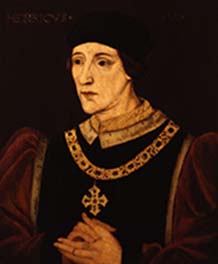Henry was born in 1421, and became King of England at the age of one. He had two reigns, due to the Wars of the Roses. The first lasted from 1411 to 1461; he was noted for his piety and general air of preferring to be left out of things. He was the only son and child of a very famous warrior, Henry V, who after the Battle of Agincourt married a daughter of the French King – Catherine of Valois. This sturdy couple managed to produce only our subject, a weakly child, disposed to illnesses and madness. During his infancy and adolescence his tutor the Duke of Bedford (a younger brother of Henry V) was regent, while another uncle, Humphrey of Gloucester was Lord Protector of England. Nothing of these three redoubtable men showed in the future Henry VI. The one useful thing he managed successfully was the founding of Eton and King’s College, Cambridge.
Due to his father’s success at Agincourt, Henry was crowned King of England and France, but the men of Burgundy, then more powerful than France itself, made a separate peace with France (CharlesVII); after this, the achievements and territories won by Henry V were dulled, and finally eroded.
By 1453, mostly because England’s rulers were unable to do much about it, only Calais was left to them. This year is marked as the beginning of a series of bouts of insanity for poor Henry. During one of these Richard, ducal head of the House of York (q.v.) seized power as Lord Protector, and started the infamous Wars of the Roses (q.v.) by defeating the king’s army at the First Battle of St. Albans, fought mostly in the narrow streets of that ancient city in Hertfordshire– of Roman foundation. It was 1455.
As detailed in a previous post, the Wars of the Roses were not a civil war at all; they were a series of bloody battles between the leading medieval families of England, mainly the houses of Lancaster and York. Our subject was a member of the house of Lancaster. After St. Albans there was a period of nervous peace, broken by murderous scuffles, but then at the Battle of Wakefield (1460) the Duke of York was himself killed. Nevertheless, the Duke’s heir Edward was declared King, which required the deposition of Henry VI, who disappeared in the direction of Scotland, guided, as usual by his uncles. It was 1461.
In 1464 Henry, by now a little more grown up, returned from Scotland with an army, to support the cause of Lancester. Little good it did him for he was captured and placed in the Tower of London, where he languished from 1465 until 1470. But then one of the super-powerful lords, the Earl of Warwick, a.k.a. The Kingmaker restored the increasingly weak and ill king to his rightful throne in October 1470. But Edward, who had escaped abroad, returned, defeated Warwick and killed him at the Battle of Barnet, following this up by thrashing the Lancastrian at the frightful Battle of Tewkesbury in the West Country, where Henry VI son, a mere teenager, was killed fighting. Edward IV settled down in the throne, most of the Lancasters were killed, and pathetic Henry was murdered in the Tower sometime in 1471, by most accounts at the personal order of Edward IV. Despite Shakespeare, Thomas More et el, there is no evidence available to connect Edward IV’s brothers Richard or Clarence or the Stafford Duke of Buckingham with the assassination of Henry VI, though they may have been near when the poor man died, probably of starvation, in the Tower.










Leave A Comment